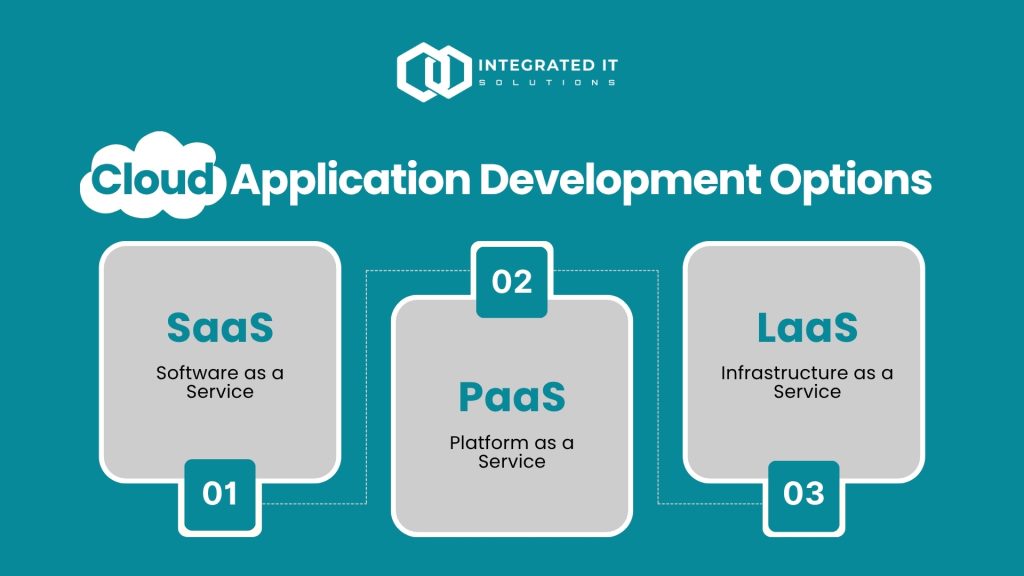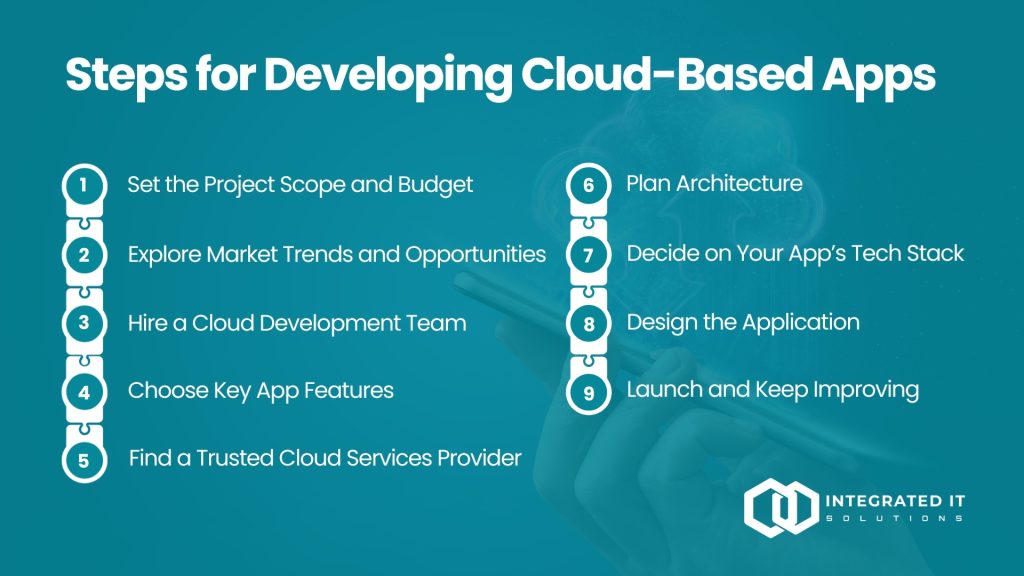These days, cloud application development is essential if you want software that’s affordable, secure, and easy to grow. Whether you’re a brand-new startup or an established company, building in the cloud gives you a flexible setup, quick rollouts, and worldwide reach, turning your ideas into real value. What are the actual advantages?
Through this blog post, you will learn everything you need to know about cloud options, service models, and the benefits of cloud-based applications. We share an extensive and complete step-by-step guide to get you started when developing your cloud application.
This guide will help you with the proper education, whether you are now exploring options or you are ready to build cloud-powered solutions for your business. Cloud convenience will give you the clarity to walk confidently into the cloud.
What is Cloud Application Development?
Cloud application development involves creating an application that utilizes cloud servers instead of local computers or on-premise servers, providing configurable or customized software to end-users.
Typically, end-users consume applications and their services through web browsers or mobile applications. However, while the end-user only sends and receives data on their device, the processing of data on cloud servers through APIs handles the heavy lifting for these users.
Different Types of Cloud-based Solutions
Cloud-based solutions are gaining popularity in enterprises due to their flexibility and numerous benefits for users. There are different sorts of cloud solutions, each tailored to satisfy a unique purpose.
Private
Private cloud-based solutions provide enterprises with greater flexibility in managing their applications and data. Unlike public cloud services, private solutions offer specialized resources for a single firm that are not shared with others.
Public
Public solutions enable people and businesses to access resources, such as storage and applications, over the Internet. Moreover, public cloud providers assume the security responsibilities and technical management of IT for organizations, allowing them to focus on their core capabilities.
Hybrid
Hybrid will protect organizations’ important data and processes by keeping some aspects private, while using the public cloud for enhanced services, and older systems. By combining private and public cloud solutions, organizations gain enhanced control and flexibility, allowing them to adapt to evolving needs.
Community
Community cloud solutions effectively serve multiple users, enabling them to work in a shared space where they can store, access, and share data. Users can collaborate as a group, enhancing their ability to access, manage, and share data.
Cloud Application Development Options
Just as with deployment services, businesses have several options for cloud application development. There are three primary types of cloud platforms that companies can choose from:

- Software as a Service (SaaS): This involves building apps that run online through various web browsers or smartphones, allowing users to access the software without installation; they need to open it and use it.
- Platform as a Service (PaaS): PaaS is the same as SaaS, in that the PaaS provider provides everything you need to develop a given app – the system and tools – and then your software is configured in the cloud.
- Infrastructure as a Service (IaaS): With IaaS, the provider takes care of your infrastructure, like servers, storage, and network, using a public or private cloud. They also offer many other helpful services in addition to it.
Examples of a Cloud Application
Cloud computing has become an appealing option for organizations seeking a more efficient way to store and manage large amounts of data. Here are some examples of where cloud technology is used to speed up data operations and obtain useful business information:
- Platform as a Service (PaaS): AWS
- Software as a Service (SaaS): Salesforce
- Infrastructure as a Service (IaaS): DigitalOcean
- Big Data Analysis: Civis Analytics
- File Sharing and Data Storage: Dropbox
- Cybersecurity: Forcepoint
- Data Governance: Carbonite
Benefits of Cloud Application Development
Companies can gain a lot from cloud application development. Here are some key benefits:
Cost-Effective
Cloud services help businesses save money. Unlike traditional in-house development, you do not have to purchase expensive hardware and set up infrastructure. The cloud provider is responsible for hosting and maintenance, which ultimately lowers the total costs.
Flexible
Traditional software limits companies with fixed setups and resources. Conversely, a cloud application enables businesses to scale up and down as needed with ease. Thus, they can adapt quickly to changing market conditions or customer demand without incurring additional costs or lead times.
Various Options
Cloud-based solutions enable organizations to scale their services and tools by offering a broader range of options through their business model. These cloud-based solutions can take many forms, including different types of applications.
Cloud-based applications encompass entire Customer Relationship Management (CRM) systems and Enterprise Resource Planning (ERP) systems. All of these applications address different components of the organization.
Competitive Advantage
Cloud application development enables businesses to create and launch apps faster and more easily than traditional methods. This gives them a strong edge over others. This provides the company with a market advantage by enabling the enterprise to save time and money, and to adjust to changes in consumer needs and the variety of open client demands.
Security
Cloud apps come with robust security features, including firewalls, encrypted data, and regular updates, to help keep your information safe from online threats. Cloud providers employ enterprise protection teams to monitor and manage security problems.
Adaptability
Instead of using in-house servers, cloud-based apps offer more freedom. One of the best things is how easily they can handle more traffic when needed, so if demand goes up, your system can grow quickly without a hassle.
9 Steps for Developing Cloud-Based Apps

To properly execute cloud application development, take these steps:
Step #1: Set the Project Scope and Budget
Start by figuring out what your app is supposed to do, which main features it must have, how much budget you have, and what goals you plan to achieve. This will make it easier to understand the market landscape, identify your customers’ needs, and determine who your competitors are.
If your budget wasn’t clear, you’ll consider options exceeding your budget. Likewise, if your goals are too broad, then everything you research will be irrelevant.
Step #2: Explore Market Trends and Opportunities
Examine what other companies are doing with their cloud applications. This way, you will be able to see what works and what doesn’t. You will also get a sense of the challenges your target audience is facing and how you can help fix them. Most of the great cloud applications developed today evolve from thorough research or finding a market gap.
Step #3: Hire a Cloud Development Team
Once you have analyzed the market, understood your user needs, and established goals for your cloud application development, your next step is to find software developers. You can:
- Hire freelancers
- Build your team
- Outsource to a development company
Cloud application development often needs updates and new features over time. So, pick a team that can make changes quickly as your project grows.
Step #4: Choose Key App Features
Pick the main features your cloud app needs. These should express the fundamental goal of your product and be easy to utilize. For now, you just want a basic version, or MVP, to assist in solving your users’ most significant problems.
Spend your time and budget on features that your target users demand. With real user testing of your MVP, you will receive feedback for future improvements on your app.
Step #5: Find a Trusted Cloud Services Provider
Finding the right provider is never easy, but it is a crucial piece of the cloud application development process. When looking for your provider, consider things like:
- Cost
- Security and the rules they follow (compliance)
- How well they work with other tools (integrations)
- Quality of customer support
Step #6: Plan Architecture
App architecture is a blueprint for how your app will function. A well-designed app will enhance performance, facilitate better growth, and facilitate seamless integration with other services. There are four commonly used application architectures for developing cloud applications:
- Monolithic applications consist of a single entity, where all the parts are integrated as one unit.
- Microservices break down the app into smaller, independent components, where each component is capable of performing a specific task.
- Serverless applications consist of minimal independent functions that are triggered by events.
- Hybrid applications are a hybrid, so they incorporate a flexible element, but this raises the risks of security and interoperability.
Step #7: Decide on Your App’s Tech Stack
There is no single optimum technology stack for cloud application development. The appropriate technology stack is determined by the expertise of your team and the project’s requirements. You should consider:
- How big is the project?
- If it needs to grow in the future
- What other tools does it need to connect with
- Any safety or security needs
Step #8: Design the Application
It is your app, so you can build it however you want, but it needs to meet the requirements of your users, and this is no more evident than in the UI/UX design. It works as well on mobile devices.
When discussing cloud application development, it is essential to ensure that the app functions smoothly on all physical screens or devices, prioritizing user-friendliness, ease of learning, and a straightforward change process.
Step #9: Launch and Keep Improving
Once everything looks good and you have finished testing, go ahead and launch your cloud application. Now you will need to troubleshoot bugs, add new features, and secure your testing environment. Updates are crucial to the success of your application for efficiency and user satisfaction.
FAQs
1. What are the common challenges in cloud application development?
Challenges include keeping cloud costs down, complying with local data regulations and requirements, and managing and monitoring across multiple cloud service providers. However, these problems can be overcome with good planning and assistance.
2. Can cloud applications work offline?
Cloud applications can be designed to support offline capabilities. You can store the data locally until you have a user connection again to sync. This is especially valuable to mobile or remote users who often experience unpredictable online access.
3. Is cloud application development suitable for small businesses?
Cloud development reduces upfront costs, allowing small businesses to develop their apps and scale over time. Many cloud providers have become a billed-on-demand service, which is the perfect option for new and growing businesses.
Final Thoughts
Cloud application development is an emerging and economical way to develop contemporary applications. It enables organizations to safeguard critical data, leverage resources as needed, and facilitate adjustments. Nevertheless, it presents challenges, such as integrating separately developed systems and identifying the right individuals. Whether you view cloud application development as all convenience, organizations ought to know the positives and negatives and adhere to a simple process.
Have questions about using cloud application development for your business? Reach out to the team at Integrated IT Solutions for software or web development. We’re here to help.





